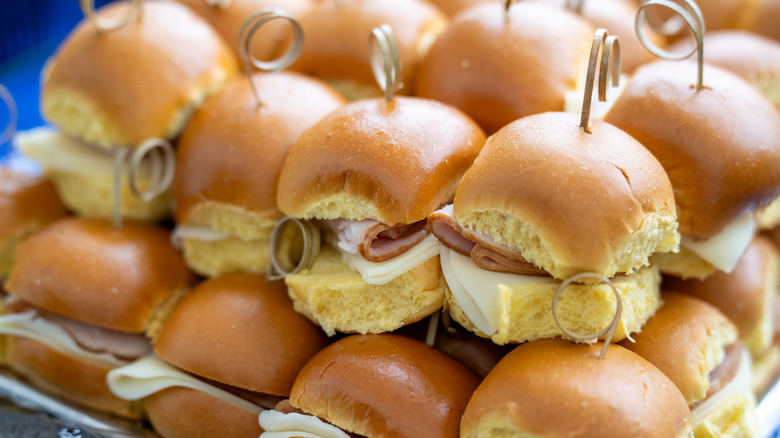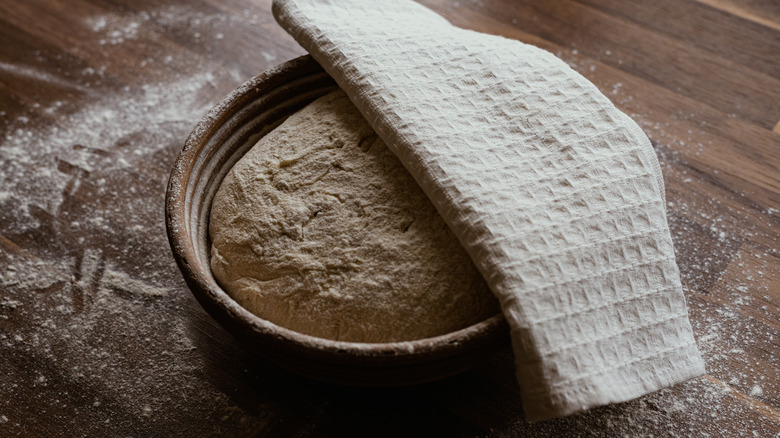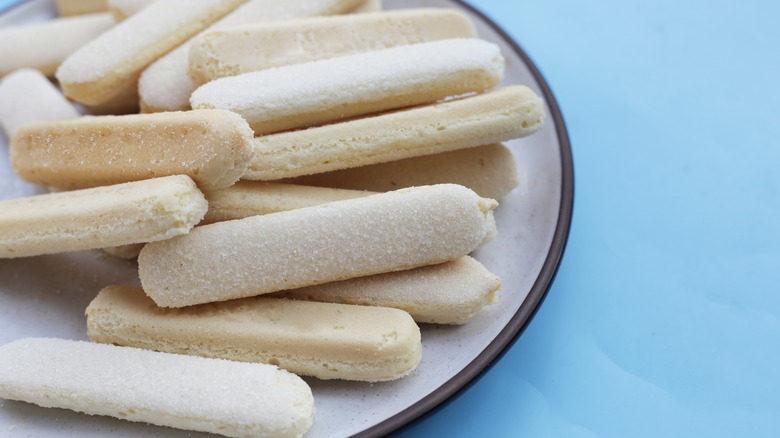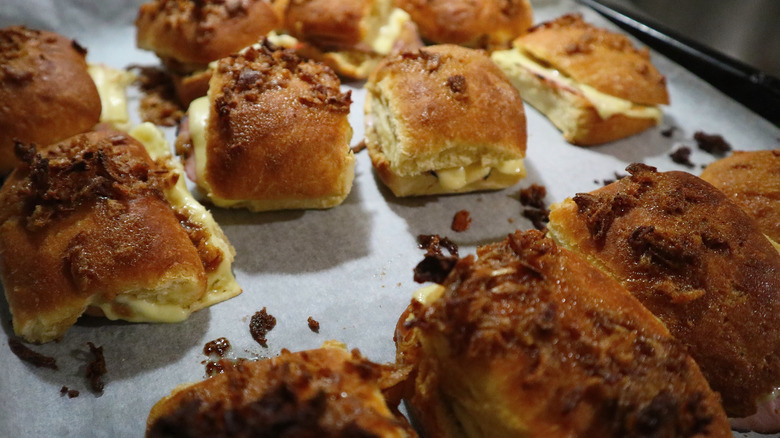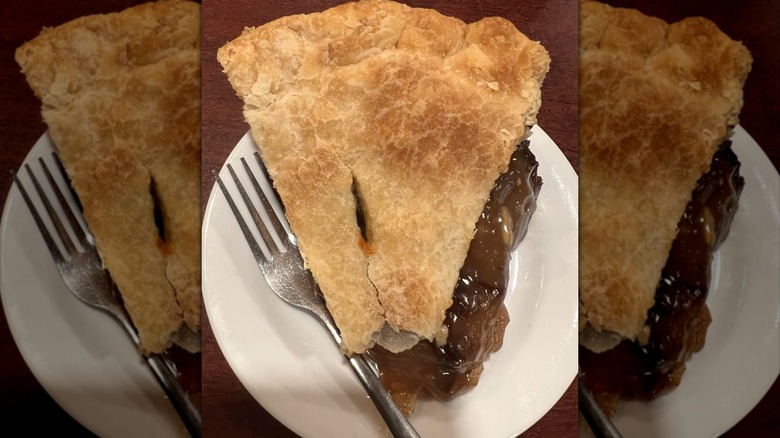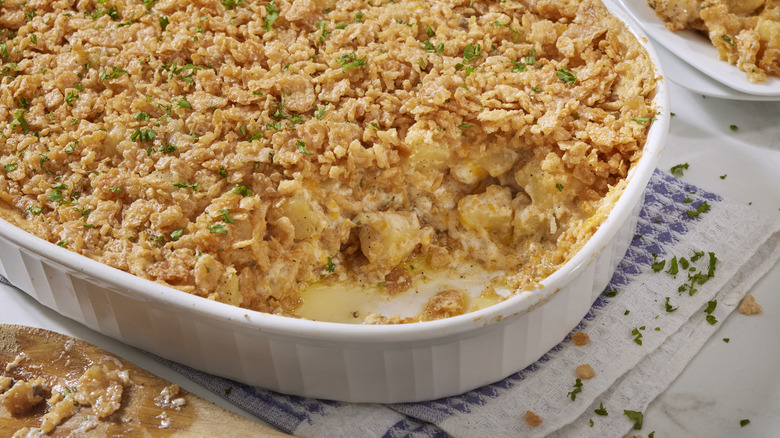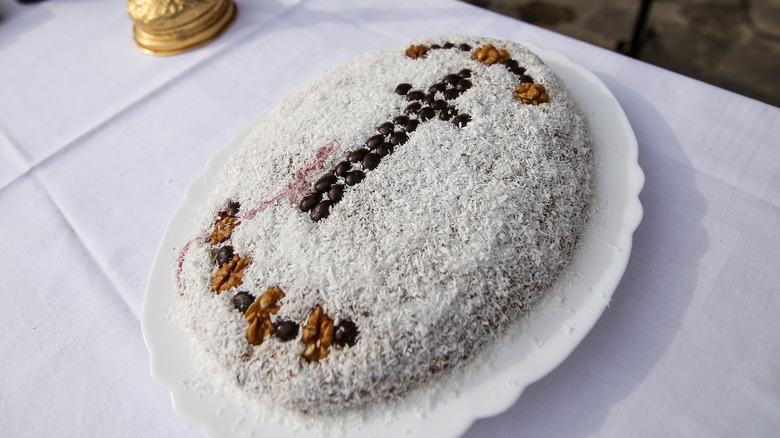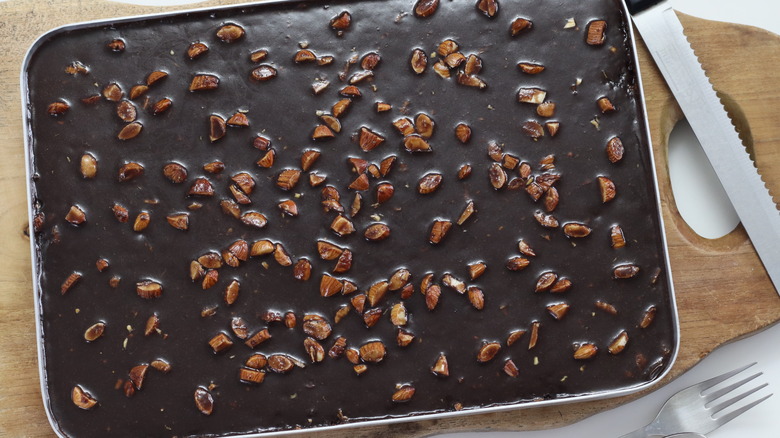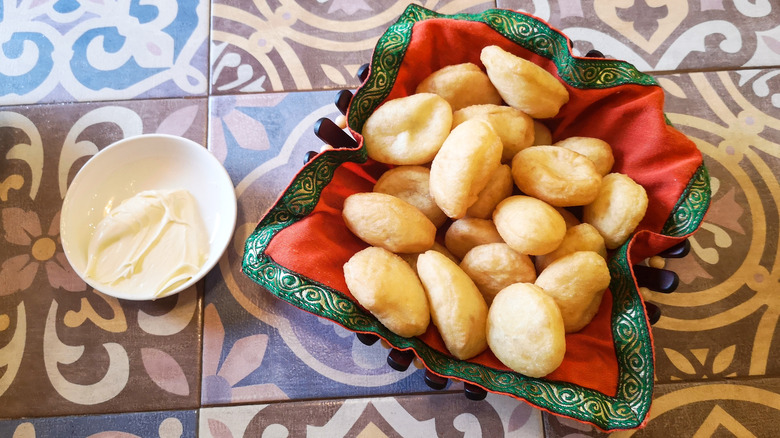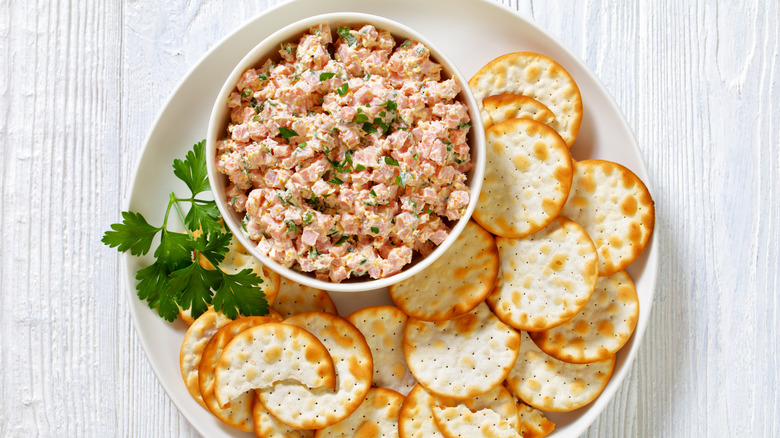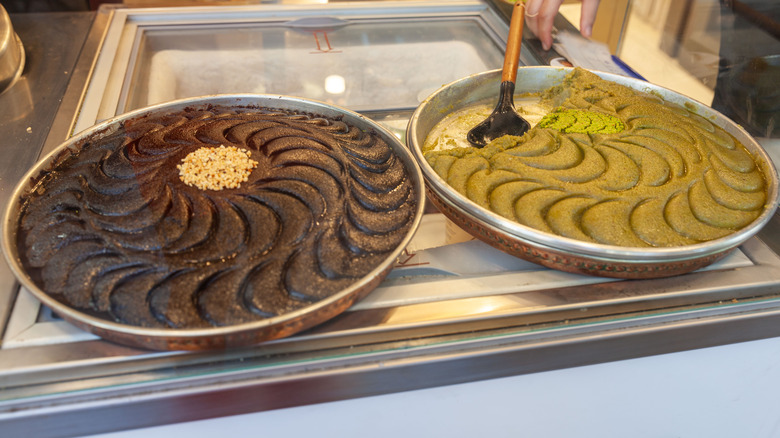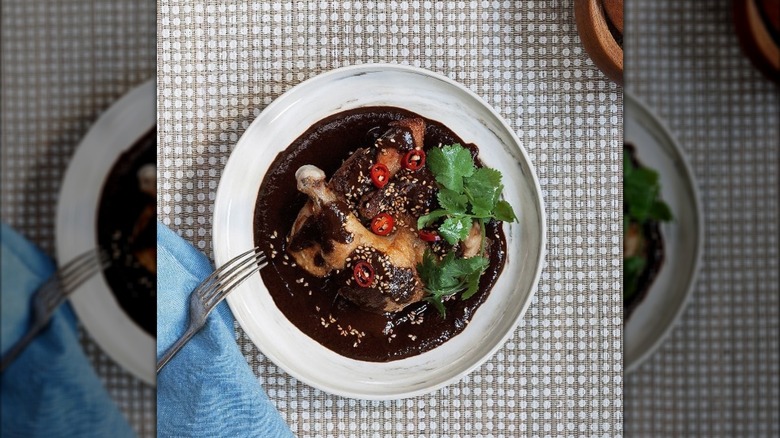12 Funeral Foods And The Stories Behind Them
Food and human gatherings go hand in hand. We gather and dine when celebrating holidays, birthdays, life milestones, or simply to enjoy one another's company. Whenever some friends or family members convene, chances are good that some food will pass hands. Of course, just as food plays a role in life's happier occasions, it holds a crucial spot during times of grief, as well — particularly when someone passes away.
Funerals and wakes have long been a time for folks to come together and mourn, of course, often while dining and drinking. Consequently, people tend to roll out substantial spreads during these events to feed those who come to pay their respects to the deceased. Concerned cooks often cobble together their best casseroles and cakes, as well, ferrying them to the mourners' households to ensure cooking is one less thing they need to think about in the days ahead.
In some instances, funeral food serves a symbolic purpose, honoring the deceased through the ingredients chosen and careful preparation methods. In other instances, funeral food is more practical, feeding as many mourners as easily and cheaply as possible. Whatever the case, some funeral foods have been lost to the past, while others have gone beyond the gravesite to become more firmly cemented in our broader diets. Here are 12 funeral foods from throughout history — some recognizable, some not-so-much — and the stories behind them.
Corpse cakes
One of the earliest funeral foods is corpse cakes — which are also one of the creepier funeral food traditions. To be clear, no: The term "corpse cake" doesn't refer to the gruesome baking projects undertaken by a Thai baker in the late 2000s, nor is the term connected to the dubious historic forensic tactic of dropping bread in water to find the corpses of the drowned. Instead, a corpse cake — which dates back to the Middle Ages) is a bread made with dough that's risen while resting on the deceased.
When making a corpse cake, the family of the departed would prepare a yeast-based dough ahead of the funeral. Once the deceased's body had been prepared for burial and rested in its coffin, the dough would be placed atop their chest to rise. After the dough had risen, it would be baked like normal, with the bread served at the funeral.
The idea was the dough would soak up the deceased person's best qualities during the leavening process; by consuming the bread, the deceased's loved ones would then carry those qualities with them. While it's a nice thought, a modern mourner is likely to wonder how sanitary it is to let bread rise in a coffin on top of a corpse.
Funeral biscuits
Funeral biscuits are an English tradition that's been around since at least the early 1800s. Mourning families would prepare round, sponge cake-like biscuits to serve to the funeral guests (along with wine). The biscuits were often wrapped in paper and sealed, as well, so guests could take the biscuits home with them after the event. However, the wrappers were what made these biscuits particularly special, as they'd often have a special message of imagery printed on them.
A biscuit's wrapper might include the deceased's name, death date, and age, for example, as well as a poem. A popular tradition throughout the Victorian era (roughly the 1820s to 1910s), funeral biscuits evolved depending on who was making them. For instance, upper class families generally preferred something more elongated, like a large lady finger, than the round spongey biscuits recorded in the early 1800s.
Additionally, those with fewer means might have flavored their funeral biscuits with ginger, molasses, or caraway. And sometimes, the printed wrappers contained rather macabre imagery. This could include sketches of coffins, skulls, or an ominous hour glass, reminding mourners of the neverending march toward the grave.
Funeral sandwiches
To be clear, you might not see a corpse cake or funeral biscuits at any 21st century funeral — after all, they've been replaced with more standard homemade or store-bought cookies (sans macabre wrappings). But you've probably seen the favorite southern funeral food known as a funeral sandwich.
Generally speaking, this funeral food contains ham, cheese, and mustard on a Hawaiian roll, though variations do exist.; for instance, mayonnaise may be used instead of mustard, or a biscuit is used instead of a Hawaiian roll. Whatever the exact ingredients are, the goal is the same: Create a bite-sized, portable sandwich that can be made en masse (cheaply) and will appeal to just about everyone.
The sandwiches are usually hot, too, making them extra delicious and comforting when people need it most. Perhaps unsurprisingly, all of these benefits have allowed funeral sandwiches to transcend the borders of funeral gatherings, as they may be enjoyed at just about any large event that calls for a potluck-style menu.
Funeral pie
While no longer quite as popular at memorial services, this old-school pie flavor known as funeral pie was once a requisite at funerals, particularly during the 1800s. A Pennsylvania Dutch creation, a funeral pie is essentially a raisin pie that's seasoned with cinnamon and contains nuts for a mincemeat-like filling. Raisin pies were so closely linked to funerals in the 1800s, in fact, that one might have feared a member of their community was reaching the end of their life by simply mentioning raisin pie was on the menu.
Raisin pies were popular funeral foods during this time for a few good reasons. Raisins were available year-round, unlike other produce used for pies, such as apples. Thanks to the preserved fruit, raisin pies could sit out on a table for a while without spoilage. Additionally, while raisins were readily available, they also were considered something of a luxury, due to the labor-intensive process of turning grapes into raisins, which requires individually deseeding and de-stemming each and every little grape. As such, the funeral pie was both a show of very generous hospitality by the funeral-hosting family, as well as a show of love and appreciation by any mourners who happened to bring it along to the event.
Today, the funeral pie's popularity is waning, even among Pennsylvania Dutch communities. Amish and Mennonite families have traded out their funeral pie for modern foods of convenience, from casseroles to even pizza.
Funeral potatoes
Funeral potatoes could easily be included among the top vintage casserole dishes that have vanished from dinner tables. The dish ticks all the boxes necessary for being considered a casserole, after all: You have a starchy base, creamy sauce, cheese, and a crunchy topping, all baked together in a casserole dish. The dish is so carb-loaded and cheese-covered that it has a certain vintage appeal as a comfort food.
Funeral potatoes can be traced to Mormon communities in the Southwest, where potluck luncheons were a popular addition to the funeral day timeline. Community members volunteer to bring dishes designed to feed a large number of people at a low cost, while still being both tasty and comforting. Clearly, funeral potatoes fit that bill.
A basic funeral potato casserole may contain frozen and/or instant potatoes, a can of creamed soup, sour cream, cheddar cheese, and the casserole-required crunchy topping (this might be breadcrumbs, crushed potato chips, or crushed corn flakes). Then again, as is the case with any good casserole, you can cobble together funeral potatoes using whatever you have on hand as long as the end result is similar.
Kollyva
Kollyva is a Greek funeral food that's rich in tradition and spiritual significance, particularly for those in the Greek Orthodox church. Like so many other funeral foods, kollyva is designed to feed a large number of people. In it, hulled and boiled wheat meets walnuts, almonds, sugar, raisins, and spices (such as cinnamon and cloves). And the entire process for making this sweet and shapen rice pudding-like dish requires a big time commitment before a funeral — over five hours.
Beyond serving kollyva at funerals and memorial services, the dish might be made to honor a deceased loved one on the 40-day and one-year anniversaries of their deaths. From a religious standpoint, the Greek Orthodox church believes the dish, in whole, represents the second coming of Christ, and the subsequent raising of the faithful from the dead. As such, each individual ingredient plays its own role: The wheat represents the soul, the almonds represent bones, while raisins and sugar represent the sweetness of Christianity.
For religious ceremonies, the dish is taken to a priest for a blessing and then served in small portions to each ceremony attendee. And while it was traditionally seen as an honor to prepare kollyva for a funeral, you can buy kollyva ready-made and thoroughly decorated in the modern world. You can then distribute it in individual portions to your guests in paper bags printed with the deceased's name, much like the funeral cookies distributed by the Victorians.
Texas funeral cake
Texas funeral cake is a rich, decadent, and large-sized cake that's easy to make, but still impressive. It features a chocolate sheet cake covered in a cooked chocolate icing, along with a smattering of pecans. It's the type of cake that seems to get better with age, too, as all of the flavors meld and the icing settles in. While it's sometimes called a Texas sheet cake, or a church lady cake, the Texas funeral cake's origins are a bit murky.
There are records of similar cake recipes being distributed throughout the South as early as the 1930s, with some saying Lady Bird Johnson invented the cake. However, the facts don't line up. Others theorize the cake just gradually evolved from German chocolate cake recipes, which became popular in Texas as the state experienced a boom in German immigration throughout the 1800s. Whatever the case, it's easy to see why this cake became a favorite at funerals, and why it's one of the top vintage cakes you need to make.
Borsok
Borsok (or borsook) is a fried dough funeral dish that hails from Kyrgyzstan. Borsok is simple, affordable, easy to make, and requires minimal ingredients, so it's accessible for any mourning family. However, like some other funeral dishes (such as raisin pie), it requires a lot of elbow grease, making it an appropriate sign of respect, admiration, and honor for the deceased. And like kollyva, borsok is also often made as a way to remember the deceased on the 40-day and one-year anniversaries of their death, as well.
These little balls of fried dough have been likened to a savory funnel cake. They're served with butter, cheese, or vegetables, but if you really want a sweet treat, you can eat them with jam or honey. In religious ceremonies, the cooking and serving of the borsok might be accompanied by a scripture recitation and prayer. Some believe the aroma rising from the borsok's cooking oil lifts the prayers to the afterlife. When the mourners sit down to eat, they're then symbolically eating on the dead's behalf.
Additionally, borsok isn't just seen at funerals in Central Asia. It can also be found at festivals and weddings, and as a part of traditional rites that occur when nomadic families travel between their summer homes in the highlands and their winter homes in the villages.
Ham salad
You might think of ham salad as just a popular sandwich option that most people don't eat anymore. But ham salad was once a very popular funeral food, and for good reason. Just as ham salad was a favorite during the Great Depression because it was affordable and an easy way to use up leftovers, it become a funeral staple for mourners needing to feed their guests on a dime.
Now, if you want a ham salad sandwich in the 2020s, there's no point in waiting around for a funeral, since it probably won't be on any modern menus. You may be able to find it at a diner, or perhaps at a Midwest grocery store. Of course, you can also make your ham salad at home, though there's no need to be thrifty by holding off until you have a leftover ham to use up (as home cooks might've done in the 1930s. Simply mix cubed ham with hard-boiled eggs, celery, relish, shallots, mustard, and mayo. You'll have a quick sandwich spread that's just as good on crackers as it is between two slices of bread.
Halva
Found throughout the Middle East, halva is a simple funeral staple made with sugar, butter, and flour. Flour is toasted on the stovetop before melted butter is incorporated. When you have a crumbly consistency, you can add equal parts sugar and water (with the sugar dissolved in the water) to form a spreadable mixture that's pressed into a pan, before designs are etched into the top. From there, it's just a matter of waiting for the halva to cool to be cut and eaten.
While this is a basic option, you can find variations on halva throughout the region, as well, with additional ingredients added or others swapped out. For example, some recipes use a plant-based oil instead of butter to make a vegan dish. In Israel, the recipe might incorporate tahini, while other cultures may see rose water syrup come into play.
Either way, halva can be traced back to at least the 1400s as a funeral food, when Ottoman warriors would have prepared it as part of the ceremonial rites honoring a fallen comrade. Those earlier versions of the recipe are still largely the same, too, relying primarily on a fat, flour, and sugar to create a confection, which is allowed to cool in decorative shapes or featuring decorative designs.
Funeral candy
Since we've had funeral sandwiches, funeral biscuits, and funeral pie, why not funeral candy, too? Similarly to funeral biscuits, funeral candy was distributed at funerals as a party favor of sorts, wrapped and ready to be taken home with mourners. Also akin to funeral biscuits, funeral candy was most popular in the 1800s — but in Sweden rather than in England, with Swedes taking it one macabre step further than the British.
Rather than simply forming the hard candy into a typical round shape, they were intended to look a little bit like a non-descript corpse. Plus, the decorative elements of the wrapping would be larger or smaller depending on how old (or young) the deceased was. Thankfully, if receiving a candy corpse is a little too grim for you, not all funeral candy was corpse-shaped; you'd get a sugar dove on occasion, or a more traditional hard candy.
Interestingly enough, this funeral food wasn't always meant to be eaten. In fact, the candies were sometimes made using inedible ingredients, such as chalk. This meant anyone who did try to eat the funeral candy found an unpleasant surprise, with their hungry attempts to eat viewed as disrespectful.
Chichilo mole
In Oaxaca, Mexico, mole isn't merely a complex, chile-based sauce that comes on your enchiladas. After all, the region is known for its moles, where the sauces play an important role. Different moles are even served at different life milestones, like the mole for death: Chichilo mole, which offers an intense, bitter flavor suitable for grief.
Chichilo blends heavily smoked chiles — specifically native chilhuacle negro chiles — with onions, garlic, and herbs and spices such as cumin, oregano, and thyme. The mole is served both before and after a burial, with accompaniments such as chicken, tortillas, and, at times, an extra portion to take home with them (a much more palatable funeral favor than chalk-filled funeral candy).
Recipes differ from family to family. Unlike some of the other moles that Oaxaca is known for, chichilo typically leaves out the chocolate, for instance, while some variations add blackened seeds and avocado leaves. Others include burnt tortilla ash or masa dumplings, or tomatillos and beef. Whatever the case, the long-standing tradition of making chichilo mole remains a treasured way to honor the diseased and remain close with the generations before them.
